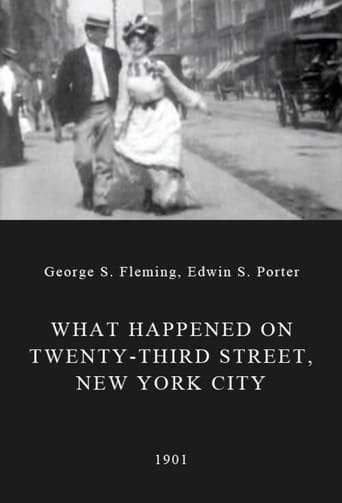Dorathen
Better Late Then Never
Lachlan Coulson
This is a gorgeous movie made by a gorgeous spirit.
Kimball
Exactly the movie you think it is, but not the movie you want it to be.
Horst in Translation (filmreviews@web.de)
A skirt was lifted in this 1901 film by notable movie pioneer Edwin S. Porter. The movie runs for roughly 90 seconds and that is already too much I would say for the content. The times where we would be happy with watching people in the streets are over in the film industry. There needs to be something more by 1901 already to keep the masses entertained. The final plot twist that answers the question in the titles wasn't bad, but it also wasn't very great to make up for the boredom from before. I cannot say that this is one of the best films from its time, although it's probably among the more known ones looking at the number of votes the title has. This may be because it's somewhat sexually explicit going by the standards of the early 20th century. Not enough though. Not recommended.
cricket crockett
Yesterday I compared Edison's 1902 rendering of JACK AND THE BEANSTALK versus the entertaining new release, JACK THE GIANT SLAYER (2013), which I had seen as a double feature the day before. The gist of knowing your Jacks was that the Edison short is morally reprehensible, while the remake teaches solid American values. When you compare notorious elephant-electrocuter Thomas Edison's WHAT HAPPENED . . . to Marilyn Monroe's 1955 remake, THE SEVEN YEAR ITCH, the EXACT SAME THING is seen. Edison's henchmen have produced something akin to kiddie porn, positioning what should be an innocent young lad of 8 or 12 as the focal point for the first 69 seconds of the 82-second offering. The corrupted boy is leering and drooling uncontrollably as the rest of the many people on the sidewalk go about their business (the Edison perverts no doubt ran the youngster through 30 or 40 takes). When it comes time for the big reveal of the unsuspecting stranger lady's unmentionables, the innocent's face contorts with an expression which should have been delayed until his honeymoon. Monroe in ITCH, on the other hand, is thrown into a trying position with another consenting adult, and the New York subway does its level best to tip the pair over the line into outright adultery. However, since Edison was not around to corrupt this pair as children when their moral fibers were woven together, the summer neighbors resist their virtually undeniable attraction despite the subway's up-blown skirting, with proper decorum and marriage vows intact at the end.
rgcustomer
I don't know if anyone has put music to this, but I saw it plainly silent.It's actually a pretty interesting film. You see the busy life of the street as people mill about the road and sidewalk. There is some horse-and-buggy and trolley traffic in the road too, and some boys with a cart.The thing that stands out first is the teenage boy (or short man) midway down the sidewalk, staring directly at us, hands behind his back, hardly moving at all, unlike anyone else we see.Why is he looking at us? What's he looking for? After a minute, we learn the reason, as the star couple walks over the grate just in front of us, and she gets her Marilyn Monroe moment.Once they pass, though, it just that boy again, staring at us, walking slowly in our direction, now shown to be carrying a lunch-box sort of thing in his right hand, and smaller parcel in his left. It's actually kind of creepy at this point, as other than the change in his hands, he seems entirely unaffected by what we all just saw.
vovazhd
What Happened on Twenty-third Street, New York City is a very old film and it clearly shows (by more than just the title). It shows people running normal errands on a typical day on Twenty-Third Street in New York City. Nothing special happens until a women and a man walk up over a hot vent that blows the woman's skirt up (not even to knee height). They laugh and then continue walking.Considering that its only 77 seconds long, there is practically nothing to lose from watching it. The plot, acting, and filming quality are really dull, but it shows how far movies have come since 1901. The fact that everything revolves around a woman walking over a steam vent is laughable.If nothing else, the glimpse of old New York is neat. It is interesting to study from a historical aspect, but probably has no real entertainment value. Then again, it will only take a little over a minute of your time, so there is little reason not to watch it at least once.

